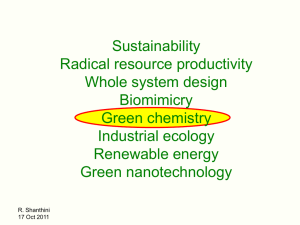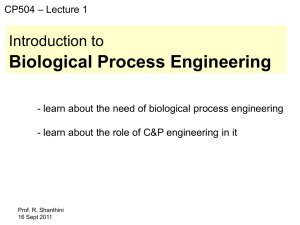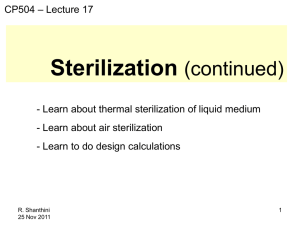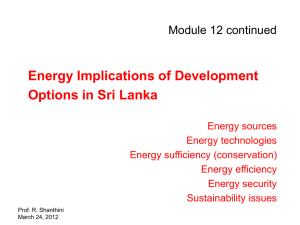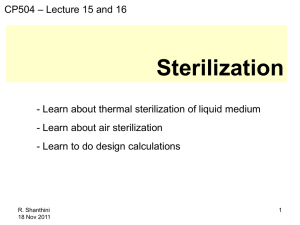Lecture4to6heattrans..
advertisement
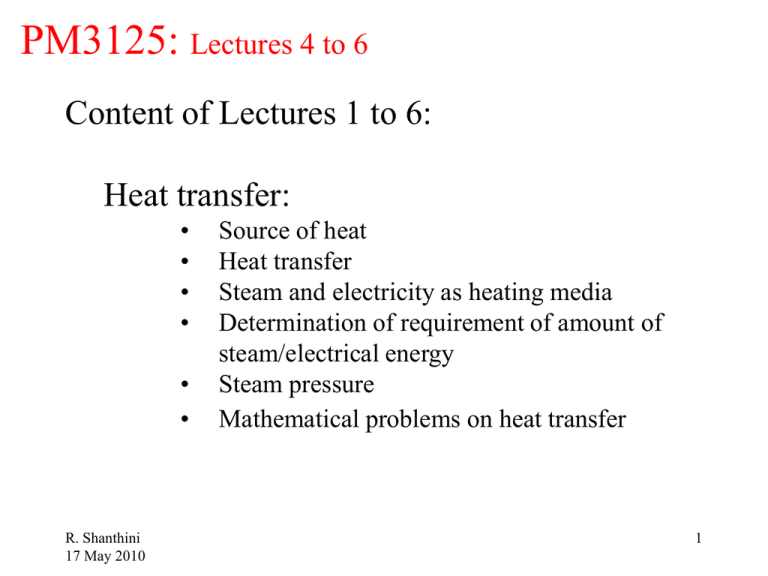
PM3125: Lectures 4 to 6 Content of Lectures 1 to 6: Heat transfer: • • • • • • R. Shanthini 17 May 2010 Source of heat Heat transfer Steam and electricity as heating media Determination of requirement of amount of steam/electrical energy Steam pressure Mathematical problems on heat transfer 1 Heat Transfer is the means by which energy moves from a hotter object to a colder object R. Shanthini 17 May 2010 2 Mechanisms of Heat Transfer Conduction is the flow of heat by direct contact between a warmer and a cooler body. Convection is the flow of heat carried by moving gas or liquid. (warm air rises, gives up heat, cools, then falls) Radiation is the flow of heat without need of an intervening medium. (by infrared radiation, or light) R. Shanthini 17 May 2010 3 Mechanisms of Heat Transfer Latent heat Conduction Convection Radiation R. Shanthini 17 May 2010 4 Conduction HOT (lots of vibration) COLD (not much vibration) Heat travels along the rod R. Shanthini 17 May 2010 5 Conduction Conduction is the process whereby heat is transferred directly through a material, any bulk motion of the material playing no role in the transfer. Those materials that conduct heat well are called thermal conductors, while those that conduct heat poorly are known as thermal insulators. Most metals are excellent thermal conductors, while wood, glass, and most plastics are common thermal insulators. The free electrons in metals are responsible for the excellent thermal conductivity of metals. R. Shanthini 17 May 2010 6 Conduction: Fourier’s Law Cross-sectional area A L Q =kA ΔT L ( )t What is the unit of k? R. Shanthini 17 May 2010 Q = heat transferred k = thermal conductivity A = cross sectional area DT = temperature difference between two ends L = length 7 t = duration of heat transfer Thermal Conductivities Substance Thermal Conductivity k [W/m.K] Substance Thermal Conductivity k [W/m.K] Syrofoam 0.010 Glass 0.80 Air 0.026 Concrete 1.1 Wool 0.040 Iron 79 Wood 0.15 Aluminum 240 Body fat 0.20 Silver 420 Water 0.60 Diamond 2450 R. Shanthini 17 May 2010 8 Conduction through Single Wall Use Fourier’s Law: T1 Q =kA . . Q ( )t Q Δx R. Shanthini 17 May 2010 ΔT L T2 T1 x . Q = k A (T1 – T2) Δx 9 Conduction through Single Wall . T1 Q = . Δx . Q Q Δx R. Shanthini 17 May 2010 k A (T1 – T2) T2 T1 x = T1 – T2 Δx/(kA) Thermal resistance (in k/W) (opposing heat flow) 10 10 Conduction through Composite Wall T1 B C A . . T2 Q Q T3 . Q = R. Shanthini 17 May 2010 kA kB kC ΔxA ΔxB ΔxC T1 – T2 (Δx/kA)A = T4 T2 – T3 (Δx/kA)B x = T3 – T4 (Δx/kA)C 11 11 Conduction through Composite Wall . Q = . T1 – T2 (Δx/kA)A = T2 – T3 (Δx/kA)B = T3 – T4 (Δx/kA)C [ Q (Δx/kA)A + (Δx/kA)B + (Δx/kA)C ] = T1 – T2 + T2 – T3 + T3 – T4 . Q = T1 – T4 (Δx/kA)A + (Δx/kA)B + (Δx/kA)C 12 R. Shanthini 17 May 2010 12 Example 1 An industrial furnace wall is constructed of 21 cm thick fireclay brick having k = 1.04 W/m.K. This is covered on the outer surface with 3 cm layer of insulating material having k = 0.07 W/m.K. The innermost surface is at 1000oC and the outermost surface is at 40oC. Calculate the steady state heat transfer per area. Solution: We start with the equation . Q = R. Shanthini 17 May 2010 Tin – Tout (Δx/kA)fireclay + (Δx/kA)insulation 13 Example 1 continued . (1000 – 40) A Q = (0.21/1.04) + (0.03/0.07) . Q A R. Shanthini 17 May 2010 = 1522.6 W/m2 14 Example 2 We want to reduce the heat loss in Example 1 to 960 W/m2. What should be the insulation thickness? Solution: We start with the equation . Q = . Tin – Tout (Δx/kA)fireclay + (Δx/kA)insulation Q (1000 – 40) 2 W/m = 960 = A (0.21/1.04) + (Δx)insulation /0.07) (Δx)insulation = 5.6 cm R. Shanthini 17 May 2010 15 Conduction through hollow-cylinder ro Ti ri To L . Q = Ti – To [ln(ro/ri)] / 2πkL R. Shanthini 17 May 2010 16 Conduction through the composite wall in a hollow-cylinder r3 r2 Ti . Q = R. Shanthini 17 May 2010 To Material A r1 Material B Ti – To [ln(r2/r1)] / 2πkAL+ [ln(r3/r2)] / 2πkBL 17 Example 3 A thick walled tube of stainless steel ( k = 19 W/m.K) with 2-cm inner diameter and 4-cm outer diameter is covered with a 3-cm layer of asbestos insulation (k = 0.2 W/m.K). If the inside-wall temperature of the pipe is maintained at 600oC and the outside of the insulation at 100oC, calculate the heat loss per meter of length. Solution: We start with the equation . Q = R. Shanthini 17 May 2010 Ti – To [ln(r2/r1)] / 2πkAL+ [ln(r3/r2)] / 2πkBL 18 Example 3 continued 2 π L ( 600 – 100) . Q = [ln(2/1)] / 19 + [ln(5/2)] / 0.2 . Q L R. Shanthini 17 May 2010 = 680 W/m 19 Mechanisms of Heat Transfer Conduction is the flow of heat by direct contact between a warmer and a cooler body. Convection is the flow of heat carried by moving gas or liquid. (warm air rises, gives up heat, cools, then falls) Radiation is the flow of heat without need of an intervening medium. (by infrared radiation, or light) R. Shanthini 17 May 2010 20 Convection Convection is the process in which heat is carried from place to place by the bulk movement of a fluid (gas or liquid). Convection currents are set up when a pan of water is heated. R. Shanthini 17 May 2010 21 Convection It explains why breezes come from the ocean in the day and from the land at night R. Shanthini 17 May 2010 22 Convection: Newton’s Law of Cooling Flowing fluid at Tfluid Heated surface at Tsurface . Qconv. = h A (Tsurface – Tfluid) Area exposed Heat transfer coefficient (in W/m2.K) R. Shanthini 17 May 2010 23 Convection: Newton’s Law of Cooling Flowing fluid at Tfluid Heated surface at Tsurface . Qconv. = R. Shanthini 17 May 2010 Tsurface – Tfluid 1/(hA) Convective heat resistance (in k/W) 24 Example 4 The convection heat transfer coefficient between a surface at 50oC and ambient air at 30oC is 20 W/m2.K. Calculate the heat flux leaving the surface by convection. Solution: Use Newton’s Law of cooling : . Flowing fluid at Tfluid = 30oC Q = h A (Tsurface – Tfluid) conv. = (20 W/m2.K) x A x (50-30)oC Heated surface at Tsurface = 50oC h = 20 W/m2.K R. Shanthini 17 May 2010 Heat flux leaving the surface: . Q conv. = 20 x 20 = 400 W/m2 A 25 Example 5 Air at 300°C flows over a flat plate of dimensions 0.50 m by 0.25 m. If the convection heat transfer coefficient is 250 W/m2.K, determine the heat transfer rate from the air to one side of the plate when the plate is maintained at 40°C. Solution: Flowing fluid at Tfluid = 300oC Heated surface at Tsurface = 40oC Use Newton’s Law of cooling : . Q = h A (Tsurface – Tfluid) conv. = 250 W/m2.K x 0.125 m2 x (40 - 300)oC = - 8125 W/m2 h = 250 W/m2.K A = 0.50x0.25 m2 R. Shanthini 17 May 2010 Heat is transferred from the air to the plate. 26 Forced Convection In forced convection, a fluid is forced by external forces such as fans. In forced convection over external surface: Tfluid = the free stream temperature (T∞), or a temperature far removed from the surface In forced convection through a tube or channel: Tfluid = the bulk temperature R. Shanthini 17 May 2010 27 Free Convection In free convection, a fluid is circulated due to buoyancy effects, in which less dense fluid near the heated surface rises and thereby setting up convection. In free (or partially forced) convection over external surface: Tfluid = (Tsurface + Tfree stream) / 2 In free or forced convection through a tube or channel: Tfluid = (Tinlet + Toutlet) / 2 R. Shanthini 17 May 2010 28 Change of Phase Convection Change-of-phase convection is observed with boiling or condensation . It is a very complicated mechanism and therefore will not be covered in this course. R. Shanthini 17 May 2010 29 Overall Heat Transfer through a Plane Wall Fluid A at TA > T1 T1 . . Q Q T2 Δx . Q = R. Shanthini 17 May 2010 TA – T1 1/(hAA) = x T1 – T2 Δx/(kA) Fluid B at TB < T2 = T2– TB 1/(hBA) 30 Overall Heat Transfer through a Plane Wall . Q = TA – T1 1/(hAA) = Δx/(kA) = T2– TB 1/(hBA) TA – TB . Q = T1 – T2 1/(hAA) + Δx/(kA) + 1/(hBA) . Q = U A (TA – TB) where U is the overall heat transfer coefficient given by R. Shanthini 17 May 2010 1/U = 1/hA + Δx/k + 1/hB 31 Overall heat transfer through hollow-cylinder Fluid A is inside the pipe Fluid B is outside the pipe TA > TB ro Ti r i To . L Q = U A (TA – TB) where 1/UA = 1/(hAAi) + ln(ro/ri) / 2πkL + 1/(hBAo) R. Shanthini 17 May 2010 32 Example 6 Steam at 120oC flows in an insulated pipe. The pipe is mild steel (k = 45 W/m K) and has an inside radius of 5 cm and an outside radius of 5.5 cm. The pipe is covered with a 2.5 cm layer of 85% magnesia (k = 0.07 W/m K). The inside heat transfer coefficient (hi) is 85 W/m2 K, and the outside coefficient (ho) is 12.5 W/m2 K. Determine the heat transfer rate from the steam per m of pipe length, if the surrounding air is at 35oC. Solution: Start with . Q = U A (TA – TB) = U A (120 – 35) What is UA? R. Shanthini 17 May 2010 33 Example 6 continued 1/UA = 1/(hAAi) + ln(ro/ri) / 2πkL + … + 1/(hBAo) 1/UA = 1/(85Ain) + ln(5.5/5) / 2π(45)L + ln(8/5.5) / 2π(0.07)L + 1/(12.5Aout) Ain = 2π(0.05)L and Aout = 2π(0.08)L 1/UA = (0.235 + 0.0021 +5.35 + 1) / 2πL R. Shanthini 17 May 2010 34 Example 6 continued UA = 2πL / (0.235 + 0.0021 +5.35 + 1) . Q = U A (120 – 35) air steel = 2πL (120 – 35) / (0.235 + 0.0021 +5.35 + 1) steam = 81 L insulation . Q / L = 81 W/m R. Shanthini 17 May 2010 35 Mechanisms of Heat Transfer Conduction is the flow of heat by direct contact between a warmer and a cooler body. Convection is the flow of heat carried by moving gas or liquid. (warm air rises, gives up heat, cools, then falls) Radiation is the flow of heat without need of an intervening medium. (by infrared radiation, or light) R. Shanthini 17 May 2010 36 Radiation Radiation is the process in which energy is transferred by means of electromagnetic waves of wavelength band between 0.1 and 100 micrometers solely as a result of the temperature of a surface. Heat transfer by radiation can take place through vacuum. This is because electromagnetic waves can propagate through empty space. R. Shanthini 17 May 2010 37 The Stefan–Boltzmann Law of Radiation Q t = ε σ A T4 ε = emissivity, which takes a value between 0 (for an ideal reflector) and 1 (for a black body). σ = 5.668 x 10-8 W/m2.K4 is the Stefan-Boltzmann constant A = surface area of the radiator T = temperature of the radiator in Kelvin. R. Shanthini 17 May 2010 38 Why is the mother shielding her cub? Ratio of the surface area of a cub to its volume is much larger than for its mother. R. Shanthini 17 May 2010 39 What is the Sun’s surface temperature? The sun provides about 1000 W/m2 at the Earth's surface. Assume the Sun's emissivity ε = 1 Distance from Sun to Earth = R = 1.5 x 1011 m Radius of the Sun = r = 6.9 x 108 m R. Shanthini 17 May 2010 40 What is the Sun’s surface temperature? Q t = ε σ A T4 (4 π 1.52 x 1022 m2)(1000 W/m2) (4 π 6.92 x 1016 m2) = 2.83 x 1026 W T4 = ε R. Shanthini 17 May 2010 = 5.98 x 1018 m2 2.83 x 1026 W (1) (5.67 x 10-8 W/m2.K4) (5.98 x 1018 m2) σ T = 5375 K 41 If object at temperature T is surrounded by an environment at temperature T0, the net radioactive heat flow is: Q t = ε σ A (T4 - To4 ) Temperature of the radiating surface Temperature of the environment R. Shanthini 17 May 2010 42 Example 7 What is the rate at which radiation is emitted by a surface of area 0.5 m2, emissivity 0.8, and temperature 150°C? Solution: Q t 0.8 Q t = ε σ A T4 [(273+150) K]4 0.5 m2 5.67 x 10-8 W/m2.K4 = (0.8) (5.67 x 10-8 W/m2.K4) (0.5 m2) (423 K)4 = 726 W R. Shanthini 17 May 2010 43 Example 8 If the surface of Example 7 is placed in a large, evacuated chamber whose walls are maintained at 25°C, what is the net rate at which radiation is exchanged between the surface and the chamber walls? Solution: Q t = ε σ A (T4 - To4 ) [(273+25) K]4 [(273+150) K]4 Q t = (0.8) x (5.67 x 10-8 W/m2.K4) x (0.5 m2) x [(423 K)4 -(298 K)4 ] = 547 W R. Shanthini 17 May 2010 44 Example 8 continued Note that 547 W of heat loss from the surface occurs at the instant the surface is placed in the chamber. That is, when the surface is at 150oC and the chamber wall is at 25oC. With increasing time, the surface would cool due to the heat loss. Therefore its temperature, as well as the heat loss, would decrease with increasing time. Steady-state conditions would eventually be achieved when the temperature of the surface reached that of the surroundings. R. Shanthini 17 May 2010 45 Example 9 Under steady state operation, a 50 W incandescent light bulb has a surface temperature of 135°C when the room air is at a temperature of 25°C. If the bulb may be approximated as a 60 mm diameter sphere with a diffuse, gray surface of emissivity 0.8, what is the radiant heat transfer from the bulb surface to its surroundings? Q t Solution: = ε σ A (T4 - To4 ) [(273+135) K]4 Q t [(273+25) K]4 = (0.8) x (5.67 x 10-8 J/s.m2.K4) x [π x (0.06) m2] x [(408 K)4 -(298 K)4 ] = 10.2 R. Shanthini 17 May 2010 W (about 20% of the power is dissipated by radiation) 46 Mathematical Problems on Heat Exchanger Tc,in Th,out Th,in Tc,out . . . Q = mc cc (Tc,out – Tc,in) = mh ch (Th,in – Th,out) R. Shanthini 17 May 2010 47 Mathematical Problems on Heat Exchanger Tc,in Parallel-flow heat exchanger Th,out Th,in Th,in Tc,out high heat transfer Tc,in R. Shanthini 17 May 2010 low heat transfer Th,out Tc,out 48 Mathematical Problems on Heat Exchanger Parallel-flow heat exchanger Th,in Th,out ΔTb T c,out ΔTa Tc,in a b . Q = U A ΔT where ΔT = R. Shanthini 17 May 2010 ΔTa - ΔTb ln(ΔTa / ΔTb) is the log mean temperature 49 difference (LMTD) Mathematical Problems on Heat Exchanger Tc,out Counter-flow heat exchanger Th,out Th,in Tc,in . . . Q = mc cc (Tc,out – Tc,in) = mh ch (Th,in – Th,out) R. Shanthini 17 May 2010 50 Mathematical Problems on Heat Exchanger Tc,out Th,in Th,in Tc,out Counter-flow heat exchanger Th,out Tc,in Th,out Tc,in R. Shanthini 17 May 2010 51 Mathematical Problems on Heat Exchanger Counter-flow heat exchanger Th,in ΔTa Tc,out ΔTb a Th,out Tc,in b . Q = U A ΔT where ΔT = R. Shanthini 17 May 2010 ΔTa - ΔTb ln(ΔTa / ΔTb) is the log mean temperature 52 difference (LMTD) Example in heat Exchanger Design An exhaust pipe, 75 mm outside diameter, is cooled by surrounding it by an annular space containing water. The hot gases enters the exhaust pipe at 350oC, gas flow rate being 200 kg/h, mean specific heat capacity at constant pressure 1.13 kJ/kg K, and comes out at 100oC. Water enters from the mains at 25oC, flow rate 1400 kg/h, mean specific heat capacity 4.19 kJ/kg K. The heat transfer coefficient for gases and water may be taken as 0.3 and 1.5 kW/m2 K and pipe thickness may be taken as negligible. Calculate the required pipe length for (i) parallel flow, and for (ii) counter flow. R. Shanthini 17 May 2010 53 Example in heat Exchanger Design Solution: . . . Q = mc cc (Tc,out – Tc,in) = mh ch (Th,in – Th,out) (1400 kg/hr) (4.19 kJ/kg K) (Tc,out – 25)oC = (200 kg/hr) (1.13 kJ/kg K) (350 – 100)oC The temperature of water at the outlet = Tc,out = 34.63oC. R. Shanthini 17 May 2010 54 Example in heat Exchanger Design Solution continued: (i) Parallel flow: ΔTa = 350 – 25 = 325oC ΔTb = 100 – 34.63 = 65.37oC ΔT = ΔTa - ΔTb ln(ΔTa / ΔTb) = 325 – 65.37 = 162oC ln(325 / 65.37) . Q = U A ΔT = (UA) 162oC R. Shanthini 17 May 2010 What is UA? 55 Example in heat Exchanger Design Solution continued: 1/U = 1/hwater + 1/hgases = 1/1.5 + 1/0.3 = 4 (kW/m2 K)-1 Therefore, U = 0.25 kW/m2 K A = π (outer diameter) (L) = π (0.075 m) (L m) . Q = (UA) 162oC = (0.25) π (0.075) L (162) kW . What is Q? R. Shanthini 17 May 2010 56 Example in heat Exchanger Design Solution continued: . . . Q = mc cc (Tc,out – Tc,in) = mh ch (Th,in – Th,out) = (200 kg/h) (1.13 kJ/kg K) (350 – 100)oC = 15.69 kW Substituting the above in . Q = (UA) 162oC = (0.25) π (0.075) L (162) kW we get L = 1.64 m R. Shanthini 17 May 2010 57 Example in heat Exchanger Design Solution continued: (ii) Counter flow: ΔTa = 350 – 34.63 = 315.37oC ΔTb = 100 – 25 = 75oC ΔT = ΔTa - ΔTb ln(ΔTa / ΔTb) = 315.37 – 75 = 167.35oC ln(315.37 / 75) . . Q = U A ΔT = (UA) 167.35oC Q = 15.69 kW; R. Shanthini 17 May 2010 U = 0.25 kW/m2 K ; A = π (0.075) L m2 58 Therefore, L = 1.59 m Other Heat Exchanger Types Cross-flow heat exchanger with both fluids unmixed The direction of fluids are perpendicular to each other. The required surface area for this heat exchanger is usually calculated by using tables. It is between the required surface area for counter-flow and parallel-flow heat exchangers. R. Shanthini 17 May 2010 59 Other Heat Exchanger Types One shell pass and two tube passes Th,in Tc,in Tc,out Th,out The required surface area for this heat exchanger is calculated using tables. R. Shanthini 17 May 2010 60 Other Heat Exchanger Types Two shell passes and two tube passes Tc,in Tc,out R. Shanthini 17 May 2010 Th,in Th,out The required surface area for this heat exchanger is calculated using tables. 61 Batch Sterilization (method of heating): Electrical heating R. Shanthini 17 May 2010 Direct steam sparging Steam heating 62 For batch heating with constant rate heat flow: Total heat lost by the coil to the medium = heat gained by the medium M - mass of the medium T0 - initial temperature of the medium T - final temperature of the medium c - specific heat of the medium q - rate of heat transfer from the electrical coil to the medium t - duration of electrical heating . Electrical heating R. Shanthini 17 May 2010 . q t = M c (T - T0) 63 For batch heating by direct steam sparging: M - initial mass of the raw medium T0 - initial temperature of the raw medium . ms - steam mass flow rate t H - duration of steam sparging - enthalpy of steam relative to the enthalpy at the initial temperature of the raw medium (T0) T c - final temperature of the mixture - specific heat of medium and water . . st) c T (ms t) (H + cT0) + M c T0 = (M + m Direct steam sparging R. Shanthini 17 May 2010 . . ms t H = (M + ms t) c (T – T0) 64 For batch heating with isothermal heat source: M - mass of the medium T0 - initial temperature of the medium TH - temperature of heat source (steam) Steam heating R. Shanthini 17 May 2010 T - final temperature of the medium c - specific heat of the medium t - duration of steam heating U - overall heat transfer coefficient A - heat transfer area U A t = M c ln ( T0 - TH T - TH ) 65 Could you prove the above? For batch heating with isothermal heat source: U A t = M c ln ( T0 - TH T - TH ) ( T = TH + (T0 - TH) exp - U A t cM Steam heating R. Shanthini 17 May 2010 66 ) Example of batch heating by direct steam sparging: A fermentor containing 40 m3 medium at 25oC is going to be sterilized by direct injection of saturated steam. The steam at 350 kPa absolute pressure is injected with a flow rate of 5000 kg/hr, which will be stopped when the medium temperature reaches 122oC. Determine the time taken to heat the medium. Additional data required: Enthalpy of saturated steam at 350 kPa = ?? Enthalpy of water at 25oC = ?? The heat capacity of the medium 4.187 kJ/kg.K The density of the medium are 4.187 kJ/kg.K and 1000 kg/m3, respectively.) R. Shanthini 17 May 2010 67 Example of batch heating by direct steam sparging: A fermentor containing 40 m3 medium at 25oC is going to be sterilized by direct injection of saturated steam. The steam at 350 kPa absolute pressure is injected with a flow rate of 5000 kg/hr, which will be stopped when the medium temperature reaches 122oC. Determine the time taken to heat the medium. Additional data: The enthalpy of saturated steam at 350 kPa and water at 25oC are 2732 and 105 kJ/kg, respectively. The heat capacity and density of the medium are 4.187 kJ/kg.K and 1000 kg/m3, respectively. Solution: Use the equation below: . . ms t H = (M + ms t) c (T – T0) R. Shanthini 17 May 2010 68 . . ms t H = (M + ms t) c (T – T0) (5000 kg/hr) (th) (2732-105) kJ/kg = [(40 m3)(1000 kg/m3) + (5000 kg/hr)(th)](4.187 kJ/kg.K)(122-25)K Taking the heating time (th) to be in hr, we get (5000 th) (2627) kJ = [40000 + 5000 t](4.187)(97)kJ (5000 th) [2627 – 4.187 x 97] = 40000 x 4.187 x 97 th = 1.463 hr Therefore, the time taken to heat the medium is 1.463 hours. R. Shanthini 17 May 2010 69 Example of batch heating with isothermal heat source: A fermentor containing 40 m3 medium at 25oC is going to be sterilized by an isothermal heat source, which is saturated steam at 350 kPa absolute pressure. Heating will be stopped when the medium temperature reaches 122oC. Determine the time taken to heat the medium. Additional data: The saturated temperature of steam at 350 kPa is 138.9oC. The heat capacity and density of the medium are 4.187 kJ/kg.K and 1000 kg/m3, respectively. Solution: Use the equation below: U A t = M c ln R. Shanthini 17 May 2010 ( T0 - TH T - TH ) 70 U A t = M c ln ( T0 - TH T - TH ) (2500 kJ/hr.m2.K) (40 m2) (tc) = (40 m3) (1000 kg/m3) (4.187 kJ/kg.K) ln[(25-138.9)/(122-138.9)] Taking the heating time (th) to be in hr, we get (2500 kJ/K) (40) (th) = (40) (1000) (4.187 kJ/K) ln[113.9/16.9] (2500 kJ/K) (40) (th) = (40) (1000) (4.187 kJ/K) (1.908) th = 3.1955 hr Therefore, the time taken to heat the medium is 3.1955 hours. R. Shanthini 17 May 2010 71 Explain why heating with isothermal heat source takes twice the time taken by heating with steam sparging, even though we used the same steam. R. Shanthini 17 May 2010 72 Question from PM3125 / Jan 2010 past paper A steel pipeline (inside diameter = 52.50 mm; outside diameter = 60.32 mm) contains saturated steam at 121.1oC. The line is insulated with 25.4 mm of asbestos. Assume that the inside surface temperature of the metal wall is at 121.1oC and the outer surface of the insulation is at 26.7oC. Taking the average value of ksteel as 45 W/m.K and that of kasbestos as 0.182 W/m.K, calculate the following: (a) Heat loss for 30.5 m of pipe length. [10 marks] (b) Mass (in kg) of steam condensed per hour in the pipe due to the heat loss. [10 marks] Additional data given on the next slide: R. Shanthini 17 May 2010 73 Question from PM3125 / Jan 2010 past paper Additional Data: i) Heat transfer rate through the pipe wall is given by, Q 2 L ( T1 T 2 ) ln( r2 / r1 ) ln( r3 / r2 ) k asbestos k steel where L is the length of pipe, T1 and T2 are the respective temperatures at the inner and outer surfaces of the insulated pipe, r1 and r2 are the respective inner and outer radius of the steel pipe, and r3 is the outer radius of the insulated pipe. ii) Latent heat of vapourization of steam could be taken as 2200 kJ/kg. R. Shanthini 17 May 2010 74 Group Assignment will be uploaded at http://www.rshanthini.com/PM3125.htm (keep track of the site) R. Shanthini 17 May 2010 75 End of slides for the heat transfer lecture R. Shanthini 17 May 2010 76 Additional material not used in the lectures. R. Shanthini 17 May 2010 77 Critical Radius of Insulation To r Insulation ro Ti ri Ti – To . Q = Pipe [ln(ro/ri)] /2πkPL + [ln(r/ro)] /2πkIL + 1/hairA Pipe resistance could be neglected R. Shanthini 17 May 2010 A=2πrL 78 Critical Radius of Insulation Ti – To . Q = [ln(r/ro)] /2πkIL + 1/(hair 2πrL) = Insulation resistance 2π L ( Ti – To) [ln(r/ro)] /kI + 1/(hair r) Convective resistance Increasing r increases insulation resistance and decreases heat transfer. Increasing r decreases convective resistance and increases R. Shanthini 79 17 May 2010 heat transfer. Critical Radius of Insulation . dQ /dr = 0 at the critical radius of insulation, which leads to rcr = kI / hair If the outer radius of the pipe (ro) < rcr and if insulation is added to the pipe, heat losses will first increase and go through a maximum at the insulation radius of rcr and then decrease. If the outer radius of the pipe (ro) > rcr and if insulation is added to the pipe, heat losses will continue to decrease. R. Shanthini 80 17 May 2010
